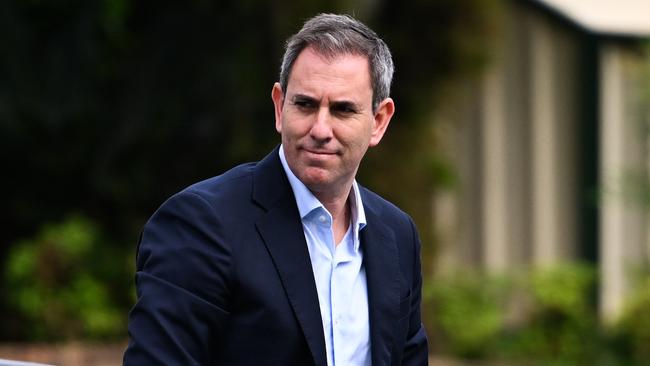No ‘wage spiral’ but RBA must be wary on rates
Jim Chalmers assured business there was no whiff of a wages spiral in Australia, despite them growing at the fastest pace in 18 months.

Jim Chalmers assured business there was no whiff of a wages spiral in Australia, despite them growing at the fastest pace in 18 months, leaving some economists and industry groups concerned that with such low productivity, the Reserve Bank might be moving too early in cutting interest rates next week.
Ahead of the Albanese government’s submission to the Fair Work Commission asking for an above-inflation wage rise for workers, business groups and economists said costs of hiring were still running too high and threatened future investment.
Wages grew 0.9 per cent in the March quarter and are up 3.4 per cent annually, above the headline inflation rate of 2.4 per cent, delivering a fifth consecutive quarter of real wage growth, official figures from the Australian Bureau of Statistics showed.
Anthony Albanese, who has contradicted RBA governor Michele Bullock by saying wages should go up by more than inflation and regardless of productivity growth, said he thought the way to deal with inflation was giving people higher wages.
“We think cost-of-living pressures are real; one way to alleviate that is to increase people’s wages,” the Prime Minister said.
OECD figures released overnight showed that real household income per capita in Australia was the biggest loser in 2024, showing the largest decline of 1.8 per cent.
Industry groups say they are worried the latest wage growth, which was driven by the public sector through state-based enterprise agreements and pay increases to aged-care workers, was coming at a time of falling productivity, which meant the true cost of hiring was becoming more expensive.
The chief executive of national employer association the Australian Industry Group, Innes Willox, said ongoing taxpayer-funded agreements were “simply not sustainable.”
“Public sector wage agreements have become increasingly out of touch with the realities of the Australian economy,” he said.
“Last year, Australia suffered through its worst year of economic performance since the recession of the early 1990s. While private sector wages are moderating to reflect this economic reality, public sector agreements continue to rise.”
Australian Chamber of Commerce and Industry chief executive Andrew McKellar said wage rises were coming at a time of low productivity, which meant higher inflation. “If you don’t have a plan for productivity, you don’t have a plan for real wages.
“And if we want to grow real wages in this country, we’ve got to get our productivity performance significantly better than it has been in recent times,” he said.
The Treasurer dismissed any concerns of higher labour costs leading to rebounding inflation.
“There’s absolutely no whiff of a wage price spiral in our economy and that’s because we’ve been getting these decent wages outcomes at the same time as we’ve been getting very encouraging outcomes on lower inflation at the same time,” Dr Chalmers said.
ACTU president Michele O’Neil said there was more wage growth in the pipeline, arguing for a 4.5 per cent minimum wage increase when the Fair Work Commission’s wage review decision is delivered in early June, impacting more than 2.6 million workers on minimum and award wages.
“There’s still a way to go, but today’s data shows the importance of having more working people able to bargain over their wages and conditions,” Ms O’Neil said
The latest figures show public sector wages rose 1 per cent in the quarter seasonally adjusted terms, slightly higher than private sector wages rising 0.9 per cent.
The public sector-heavy ACT showed the biggest rise, with wages up 3.9 per cent.
While financial markets are pricing in a 0.25-percentage-point interest rate cut next week when the RBA meets, some economists are wary its outlook might be too optimistic.
Judo Bank’s chief economist, Warren Hogan, said the RBA’s preferred measure of Labour Unit Costs – which take into account the hit to productivity and therefore the extra costs business has to cover to keep operations at pace – was still around 5 per cent growth, making it inflationary.
“The key measure the Reserve looks at is wages adjusted for productivity, which is business unit costs; and that is still far higher than inflation,” Professor Hogan said.
“It all points to the fact that we have not got rid of inflation.”
EY economist Paula Gadsby said the RBA would be considering low productivity rates when making its interest rate decision.
The central bank “looks at both measures but focuses more on unit labour costs than wage growth when assessing inflationary pressures as it accounts for total labour costs per unit of labour rather than changes in wage rates,” she said.




To join the conversation, please log in. Don't have an account? Register
Join the conversation, you are commenting as Logout